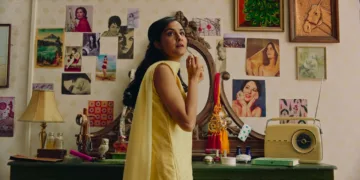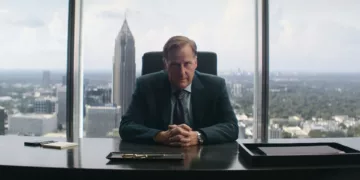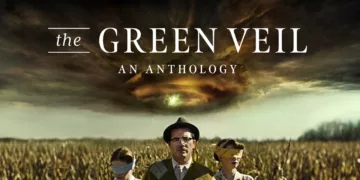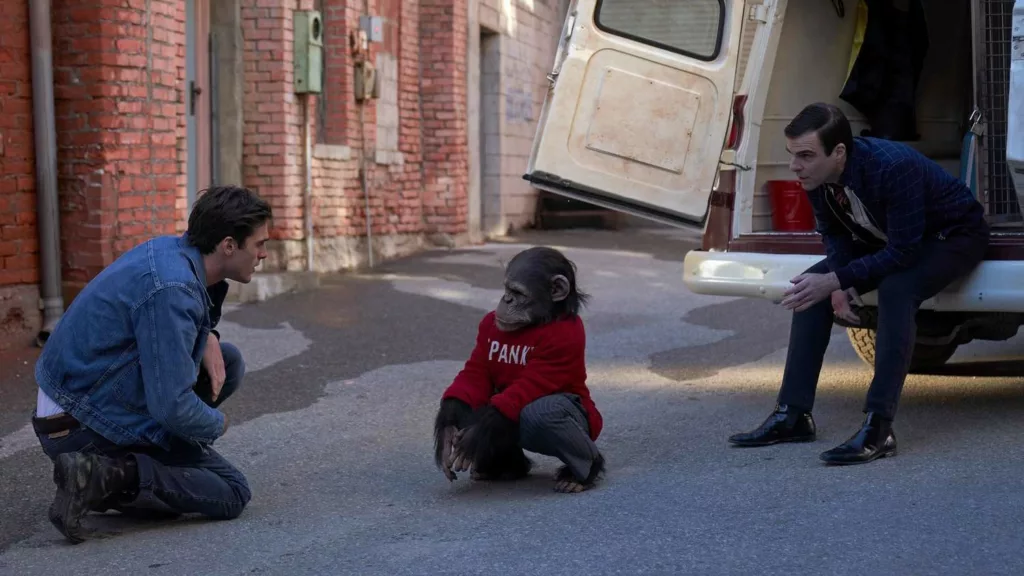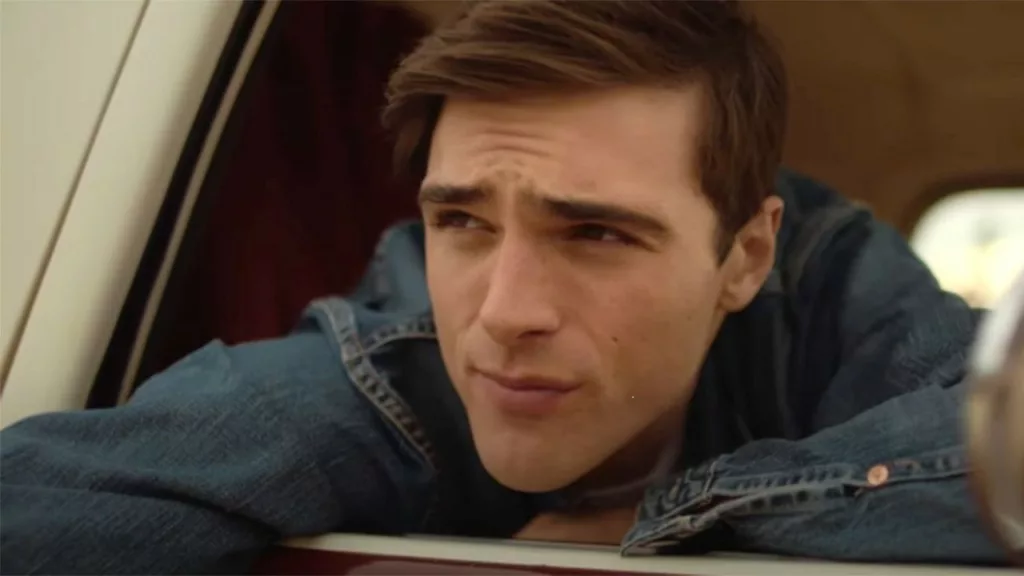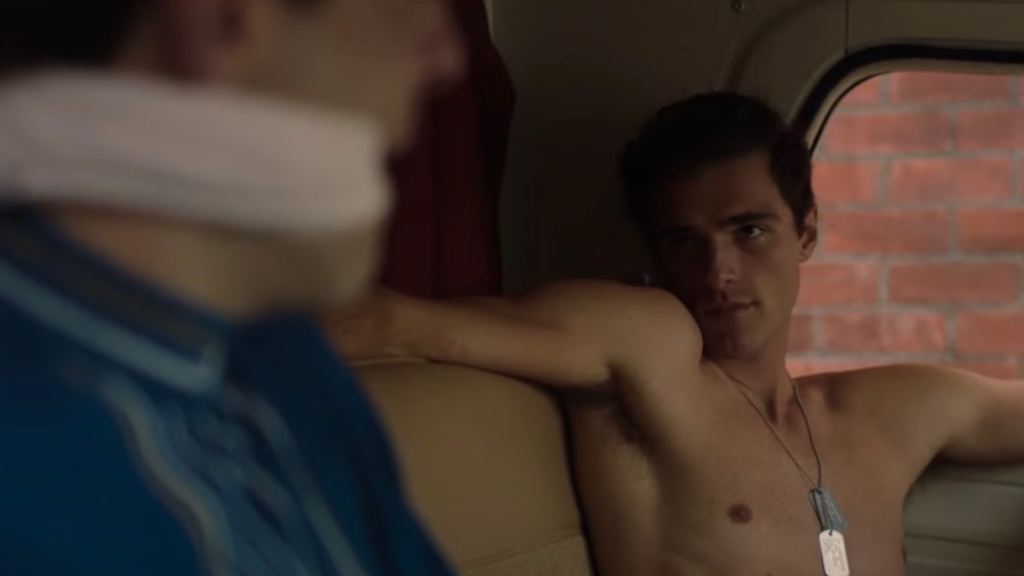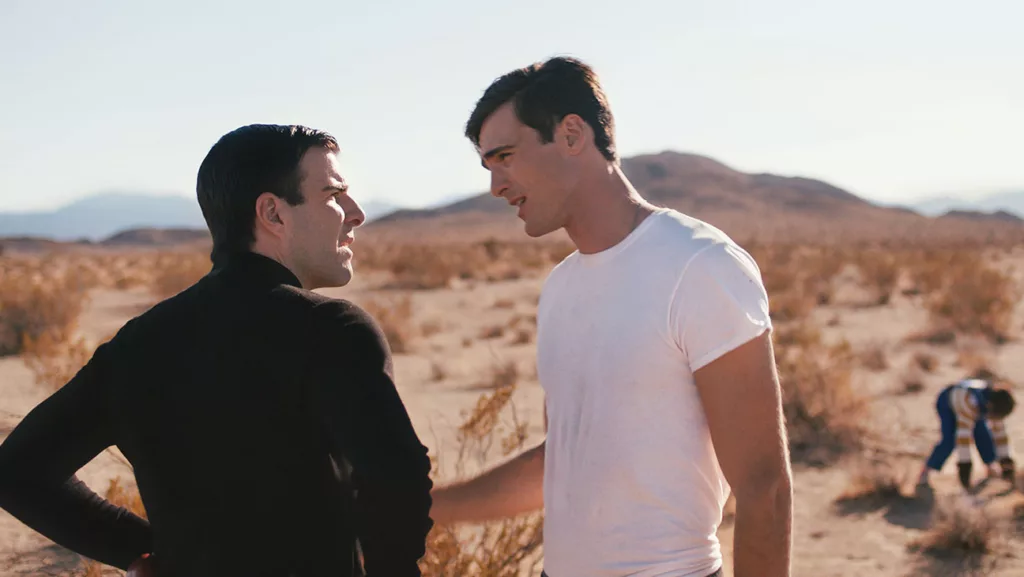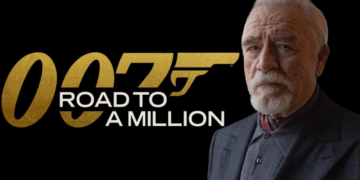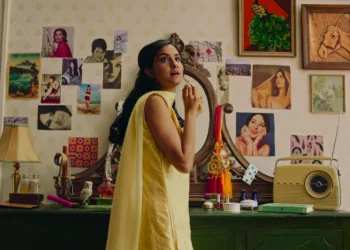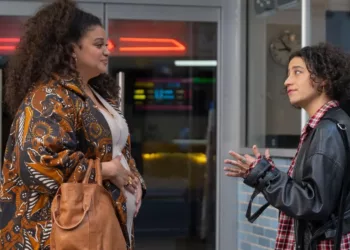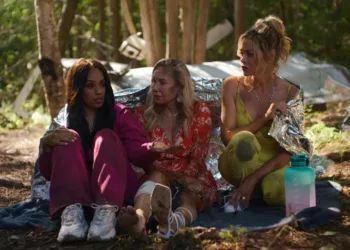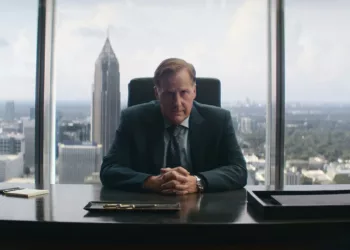A serial killer and a celebrity chimp walk into an old station wagon. It sounds like the setup for a bizarre joke, but it’s actually the premise of He Went That Way, a new thriller inspired by some peculiar true events. This offbeat buddy road trip flick aims to fuse chills with oddball charm, but does it succeed?
In short, despite flashes of intrigue, the film never quite hits its stride. We follow animal trainer Jim (Zachary Quinto) as he gives a ride to young drifter Bobby (Jacob Elordi) across the dusty highways of 1964 America. But their journey gets hairy when Bobby reveals his murderous tendencies, forcing Jim to balance self-preservation with his desire to reform the troubled hitchhiker. Meanwhile, Jim’s scene-stealing sidekick Spanky the chimp lightens the mood from the backseat.
On paper, it’s a recipe for escapist fun. Yet the finished product leaves much to be desired. For all their talent, the lead actors struggle to sell an undercooked central relationship. And director Jeffrey Darling brings little vision or tension to what should be a high-stakes game of cat and mouse. Still, there are enough glimmers of wit and style here to offer casual viewers some modest rewards.
In the end, He Went That Way is a missed opportunity – the kernel of something fresh and exciting that never blossoms into a satisfying whole. It may amuse you in fits and starts, but don’t expect an offbeat gem for the ages.
A Killer Ride
The film hits the ground running with a cold open that encapsulates Bobby’s psychopathy. We see the young serial killer cruising down a desert highway next to an unassuming man who has a fresh bullet hole in his temple. After dumping the body without flinching, the story then rewinds to explain how this killer and his chimp entourage came to be.
We land in the Death Valley heat, where animal trainer Jim is driving his temperamental station wagon down Route 66 to Chicago. Times are tough for performers like Jim in the wake of the British Invasion, and he’s struggling to book gigs for his once-famous chimp companion Spanky. When his jalopy breaks down at a remote gas station, Jim makes the fateful decision to pick up a handsome young hitchhiker named Bobby.
At first, Bobby seems affable enough, if a bit defensive about his past. But trouble is clearly afoot from his slimy vibes and mysterious discharge from the Air Force. The truth comes out soon enough when Bobby pulls a gun on Jim and steals his cash and prized ring after their first pit stop. Yet in an astonishing act of grace or stupidity, Jim agrees to drive the volatile criminal across the country if he’ll just return his stolen goods.
What follows is a series of close calls and mind games as Bobby continuously asserts his dominance through violence, only to later bond with Jim over music, drinks and late-night confessions. Jim foolishly believes he can nurture the good in Bobby’s broken soul, while Bobby remains calculating in his efforts to dupe and control Jim. All the while, the sight of sweet Spanky the chimp lightens things up in the backseat, oblivious to the danger at hand.
Through revealing flashbacks of Bobby’s abusive upbringing, we gradually understand how he became so hardened and cruel. But his sputtering attempts at warmth and redemption on the road ring hollow. When his girlfriend rejects him in Chicago, exposing his lies to Jim once and for all, Bobby finally snaps. In the chilling climax, the psychopath takes Jim on a suicidal cop chase into the city, bringing their twisted trip to its inevitable explosive end.
Somehow the trio of travellers make it to Chicago in one piece, but not without trauma, disillusionment and Bobby’s body count rising ever higher. This “mostly true” story is a tense collision between innocent optimism and cold-blooded compulsion. And you’ll never look at hitchhikers or chimpanzees the same way again.
Discover the Fate of Hardin and Tessa’s Saga: “Embark on the final chapter of the tumultuous romance in the After movie series. Dive into our After Everything Review to see if the epic love story of Hardin and Tessa finds its resolution in this much-anticipated finale.”
Searching for Humanity on the Open Road
Beyond its surface-level thriller, He Went That Way strives to probe more profound themes about human nature through the frame of 1960s America. We’re presented with two archetypes – the wholesome all-American boy in Jim and the violent rebel without a cause in Bobby. Their ideological clash on the highway examines whether one can ever redeem those who seem bereft of goodness or humanity.
Jim sees only Bobby’s potential, believing that compassion and guidance can heal even the most broken men. Bobby, meanwhile, seems to relish inflicting cruelty and preying upon Jim’s naive optimism. This speaks to an eternal conflict regarding the balance of good and evil in people – are we doomed by our worst impulses or capable of rising above through self-improvement?
The open road further symbolizes the randomness that governs our mortal lives. Our journeys intersect haphazardly with strangers, for better or worse, based on split-second decisions. Had Jim not stopped for Bobby, five lives may have been spared – and yet he feels duty-bound to extend kindness to those in need. Life thereby hangs on precarious threads of fate over which we exert little control.
We also examine the transitioning iconography of 1960s masculinity. Jim’s schtick of chimp hijinks represents the old guard of wholesome family entertainment, fading in the wake of rock n’ roll’s dangerous sex appeal. Meanwhile, the all-American discipline of military service has molded Bobby into a weaponized loose cannon. These characters depict men searching for purpose and identity at a crossroads of cultural change.
Finally, the film meditates on our appetite for distraction through the metaphor of Spanky’s declining celebrity. Once a shining TV star, Spanky now elicits pity as a roadside attraction commodity. Much as the bright lights of Hollywood champagne eventually go flat, our cultural obsessions burn fast and bright then quickly fade. Perhaps chasing fame and fortune distracts from life’s deeper rewards.
Altogether, beneath its sensationalist pirate packaging, He Went That Way harbors contemplative themes about moral choice along the journey of life. Whether it finds profundity or platitudes likely depends on each viewer’s worldview. But the quest for meaning echoes down America’s endless asphalt arteries.
Capturing the Beauty and Grit of the Open Road
He Went That Way thrives primarily as a visual feast capturing the romanticism of 1960s Americana along the iconic Mother Road. Through picture-postcard cinematography and meticulous period details, director Jeffrey Darling transports us right into the vanishing world of roadside attractions and two-lane blacktop pilgrimages.
Cinematographer Xavier Grobet delivers lush landscape tableaus situating the story across the Southwest. We linger on striking shots of Death Valley at golden hour, the cast in perfect silhouette against slashes of red rock buttes. The retro cars, diners, and motels all bask in a nostalgic glow accentuated by vibrant neon signage at night. Grobet’s magic-hour hues and carefully composed travel shots romanticize the open highway, summoning the wanderlust freedom embodied by Route 66.
The art department also nails 1960s period authenticity through vehicles, costumes and production design. Bobby’s leather jacket, plain white tee, and cigarette pack rolled in his sleeve sleeve epitomize James Dean rebel style. Meanwhile, the wood-paneled station wagons, smoky pool halls and swanky big band venues transport us to a bygone era of American leisure and vice. This road trip plays out like a loving requiem to the Mother Road legacy.
That said, some technical elements clash with the period realism. The attempts to portray Spanky the celebrity chimp prove decidedly low-budget, undermining the movie’s prestige. The animatronics and costume suit for Spanky appear conspicuously fake, lacking the seamless poetry of modern CGI. Whenever the gimmicky chimp hijinks commandeer focus, the otherwise polished production value takes a hit. We can only suspend so much disbelief seeing such an unconvincing simian tagalong.
Still, aside from theimmersion-breaking monkey business, He Went That Way gifts audiences gorgeous compositions and transportive venues straight out of a faded photograph. The visuals alone may justify the price of admission for Route 66 enthusiasts or lovers of throwback Americana. Just don’t expect an A-list primate performance worthy of the story’s stranger-than-fiction folklore.
Complex Characters Seeking Purpose
The beats of this familiar thriller rely on the interplay between two complex characters seeking meaning and connection amidst personal turmoil. At surface level, Jacob Elordi and Zachary Quinto deliver rock-solid performances as the oddball road trip duo. But peel back the layers and we find each man struggling with identity, trauma and their place in the world.
As Bobby, Elordi brings intoxicating dynamism to an entitled sociopath. He slithers from suicidal to seductive in a snap yet evokes empathy despite his heinous violence. We witness flashes of a wounded boy still mourning the abuse and neglect of his childhood. Is Bobby purely a stone-cold killer, or a damaged soul crying out to be saved? Either way, he’s electrifying to watch.
Meanwhile, Quinto plays Jim as a paragon of patience and compassion, albeit one clinging to false hope. He anchors the film with nuance and depth as a good man recently hardened by the pitiless nature of showbiz. Jim sees himself in Bobby – another struggling outsider fighting upstream against indifference while nursing private pain. Their yin-yang dynamic hums thanks to Quinto’s grounded wisdom balancing Elordi’s loose-cannon intensity.
And then there’s Spanky – the monkey in the room. Though largely a sideshow attraction adding zany flavor, he echoes the central relationship’s uneasy power roles and affections. We sense Jim’s paternal love for Spanky despite viewing him as a meal ticket first. And Bobby forms a childlike bond with the chimp, probably the only creature he sees as beneath him to dominate. Spanky thereby becomes a barometer for who wields control of the road trip – and just how unbalanced things have become.
Some critics argue the stakes and motivations get muddled in service of these quirky character studies. But at its core He Went That Way is propelled by people, not plot. It works best as a window into the psyches of two drifters using each other to fill voids – a surrogate father figure clinging to faded glory, an abandoned boy seeking someone who won’t give up on him. The tragic climax then hinges on the revelation that for all their personal demons, Bobby and Jim essentially want the same thing: to feel wanted by someone, anyone at all.
Whether their winding parable succeeds at profundity or falls to pretention is up for debate. But the appeal lies in Elordi and Quinto wrestling with timeless questions of purpose and connection on the long and lonely highway.
Missed Potential Along the Mother Road
He Went That Way brings undeniable curiosities to the table. A chimpanzee buddy movie meets cat-and-mouse serial killer road trip should equal escapist bliss. And leading men Elordi and Quinto have more than enough talent and magnetism to sell even shallow characters. So why does the final product underdeliver on expectations?
For starters, the central relationship lacks meaningful development, guts or believability. Bobby flips randomly from playful to homicidal then back in a whiplash fashion we just have to take in faith. And Jim’s oscillator between paranoid hostage and Stockholm syndrome caregiver strains logic as well. Their dynamic borrows heavily from previous oddball couples on the run minus the emotional stakes needed to invest in the outcome.
Which speaks to thinly-written roles failing to ground this admittedly outrageous premise in psychological truth. We get tantalizing clues to inner demons but not enough backstory to explain the leads’ questionable choices. Elordi tries mightily to sell Bobby’s mercurial emotions but is hamstrung by a patchy script. And Quinto struggles to reconcile Jim the hopeful humanitarian with his bursts of vengeance and cynicism. Both deserved better character scaffolding to properly showcase their skills.
Most disappointingly, the wild potential of this stranger-than-fiction tale goes largely untapped. Beyond hints of social commentary weaving throughout the journey, there is scant examination into the sociopathic mind, guilt-ridden obsessions, questions of fate and morality that seem ripe for exploration here. The story unwinds mainly at surface level when probing darker themes could have elevated its pulp into significance. Think Natural Born Killers rather than a thin True Crime potboiler.
Alas, He Went That Way mostly coasts on its eccentricities without enough substance or imagination to carry the premises into greatness. Where it finds modest success is through gorgeous photography and art direction conjuring both the romanticism and loneliness baked into the Mother Road mythos. There may be just enough style and enigmatic atmospherics here to please less demanding viewers who prioritize mood over meaning. But overall this ends up a disappointing trip given the candid weirdness of its inspiration begging for thoughtful daring.
Parting Thoughts from the Open Road
At the end of this long, strange trip lies a missed opportunity. He Went That Way offers just enough morsels of intrigue to leave us wanting more – much more – from its offbeat premise and pedigreed leads. Instead, meandering pacing and thin character development waste too much gas puttering down forgettable detours.
The performances prove solid given limited material, with Elordi unleashing manic charisma that desperately needs focused shaping. And Quinto brings dignified grace, even if the script sell his motivations short. What suspense emerges across sun-baked vistas owes tribute to Grobet’s rich photography capturing fleeting American mirages. But for all its aesthetic appeal, the story rings hollow, missing the final sparks that might have ignited something deliciously weird into enduring folklore.
So I can only offer cautious recommendation for the patient road warrior seeking distraction over depth. Undemanding audiences may delight in Elordi’s unhinged hijinks alongside his furry sidekick. Yet that chimp gimmick points to the film’s broader lack of resonance once the credits roll. We glean glimmers here of pointed perspective that dissolve like desert spectral mirages.
He Went That Way is no disaster, rather an appreciable curio lacking the nerve or vision to navigate its offbeat premise home. I kept waiting for the real story to begin. Instead, we wind up with a modest detour easily forgotten when mapped onto cinematic history’s endless open road.
The Review
He Went That Way
Despite flashes of potential and talent, He Went That Way never fully shifts into high gear, coasting on quirky personalities without enough direction, thematic fuel or narrative bite to leave a lasting impact. It's fitfully entertaining but ultimately lands as a middle-of-the-road misfire given the richness of its inspiration.
PROS
- Captivating performances by Elordi and Quinto
- Fascinating true crime premise with memorable odd couple paring
- Gorgeous cinematography brings 1960s Route 66 landscapes to life
CONS
- Lack of suspense/psychological depth in central relationship
- Unfocused tone and thematic reach
- Major plot holes and questionable character choices
- Bizarre undeveloped tangents (the preacher brother, etc.)
- Unconvincing chimpanzee puppetry takes you out of the drama

